introduction to art history and museum studies | Quizlet
1/178
There's no tags or description
Looks like no tags are added yet.
Name | Mastery | Learn | Test | Matching | Spaced |
|---|
No study sessions yet.
179 Terms
What was the historical context of the transition from modernism to post-modernism?
1945-present
Post-war and Cold War Era (WWII saw rise of new superpowers, USA and Soviet union, and beginning of the Cold War)
What was the importance of MoMA (Museum of Modern Art) director, Alfred H. Barr Jr's, scheme from 1936?
Foundational for the canonization of modern art
Showed how different movements in history led towards modernism (non-geometrical and geometrical abstract art)
- emphasis on cubism
- his perspective was linear and Eurocentric
first director of MoMA
Who was Clement Greenberg?
an important advocate for american abstract art
- argued for an emphasis on medium and abstraction, as well as linear development
- not so much what we are seeing, but the medium in which it is shown
What is the technique known as dripping and what artistic movement is it from?
its from post modernism
- dripping paint on canvas on the ground to create optic effect
ex. Jackson Pollock, Number 1
What is kitsch?
means "not art"
What was Conceptual Art?
Concept/idea is ultimately more important than the expression of the artist, who makes it, or where
- Was in reaction to Abstract Expressionism
"Cognitive, instead of affective"
- had impressions of seriality (serial layout or arrangment)
Why can Conceptual Art make people annoyed and frustrated?
challenges our own conception of what art is
ex. something as simple as lines such as Sol Lewitt's "Lines in Four Directions" which is literally lines in four directions
- what are the confines of art?
What is Pop art?
Appropriation of pop culture
- modernist strategy (collage) used to parody consumer and mass culture
- was in reaction to 'serious' style of Abstract Expressionism
- seriality also seen here
- repetition
- mixing of high and low culture (throwing things together that might not be seen as the same way)
- television becoming ubiquitous (seen everywhere)
All manifestoes make use of what kind of language?
Provocative language (war, aggression, exclamation marks)
What is period eye?
For the authors of manifestos, their proposed revolutions cannot be achieved without a strong break from __________________
without a strong break from traditional structures (e.g. museums in Futurism, conventional language in Dada, natural form in De Stijl, or Portuguese colonization in the Cannibalist manifesto
What is the intention of a manifesto?
A written statement declaring publicly the intentions, motives, or views of its issuer
- often used by modernist artist groups between 1900 and 1940
its meant to break traditions; not meant to be a logical or easy read
- not to be read like a textbook with authority
What is the difference between modernism and post-modernism?
Modernism: "Less is more"
Post-modernism: "Less is a bore! More is more!"
p.s. pos-modern usually used to describe art after 1970
What are the ideals of modernism?
revolution, utopia, universalism
What is pluralism?
concept that recognizes and embraces a diversity of perspective, ideas, and cultural expressions within a single framework
What are characteristics of post modernism?
- Art does not develop in a linear way (see avant-garde movements), and without totalizing narratives about society (as opposed to manifestos) --> plurality
- Art is not autonomous: it does not distinguish itself from other objects by definition
- Art gains meaning through its relation with the viewer --> artistic intentions do not matter as much for the interpretation
- Merging of 'high' and 'low culture
- From focus on painting, or canvas as medium of painting (greenberg) to multi-media
What does "avant-garde" mean?
artists, movements, and works that are revolutionary and ahead of their time
What was the historical context of Modern art/Modernism?
1900-1945
- World War I (1914-1918) and World War II (1940-1945) drastically reshaped the geopolitical landscape
- Technological innovations --> invention of airplane, radio, and television --> intensified global communication
- also, development of nuclear weapons during WWII put pressure on international relations
- Social and political developments --> new ideologies (i.e. Facism, Nazism, and Communism), totalitarian regimes, women's rights, decolonization
When was World War I?
1914 - 1918
When was World War II?
1940-1945
What are the many 'isms' of modern art?
Post-impressionism, symbolism, fauvism, expressionism, cubism, futurism, dadaism, surrealism, suprematism
There was an acceleration in modernity, with rapid stylistic developments
--> everyone wanted to be the "first"
What was post-impressionism and when did it take place?
After 1886 (late 19th century)
- after impressionism was established
- stylistically more diverse than impressionism, not as easily categorized
More abstraction than impressionism (ex. Starry Night)
- Paul Cezanne, Van Gogh, George Sepuat, and Gauguin
Who was Paul Cezanne?
Was a bridge figure between late 19th century romanticism --> moving to impressionism --> post-impressionism and prefiguring --> cubism in the early 20th century
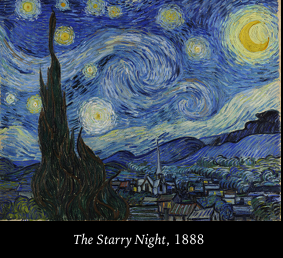
What "ism"" was Van Gogh's painting, The Starry Night, an example of?
Post-impressionism
- more abstraction than previous paintings like The Clichy Bridge (impressionism)
- played more with the realm of painting
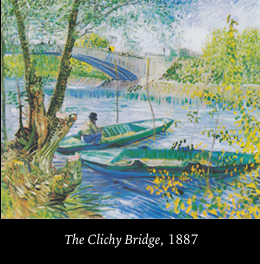
What is pointilism?
the use of little colored dots to create effects
ex. Georges Seurat, A Sunday on la Grande Jatte
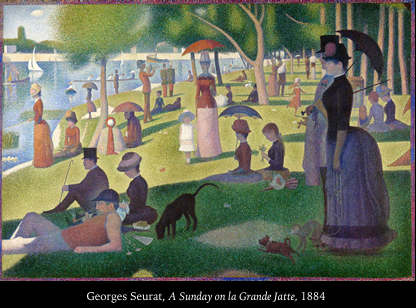
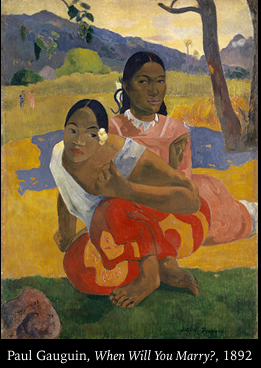
What was primitivism?
post-modern style; part of post-impressionism
Paintings in a colonial context and eurocentric vision; aesthetic idealization
ex. Paul Gaugin, depicted Tahiti as a non-modern/primitive place
What was symbolism and when/where did it take place?
From late 19th century onwards
France
In reaction to Realism, return of emotions
Subjectivity, spirituality, and dreamlike atmospheres; not really concerned with real-life
Return of religious and mythological subjects; Gustave Moreu as protagonist
was an inspiration for surrealism
precision and detail still influences of the Paris academic art salon different from other modernist styles with more clear stylistic break
wasn't necessarily radical
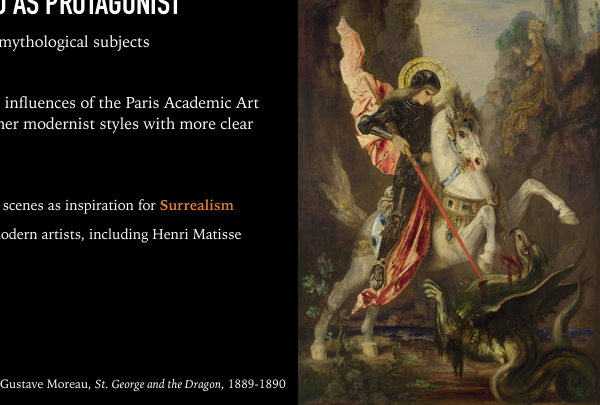
What was Fauvism and when/where did it take place?
France
Early 20th century, since 1905
Vivid and arbitrary colours; stark color contrasts
sense of ‘flatness’ (color of the table cloth are merged with the red background); but perspective achieved through the chair, human figure, and window view
Subjectivity, simple forms
ex. Woman with a Hat, Henri Matisse, 1905 —> no shadows on the face, green colours
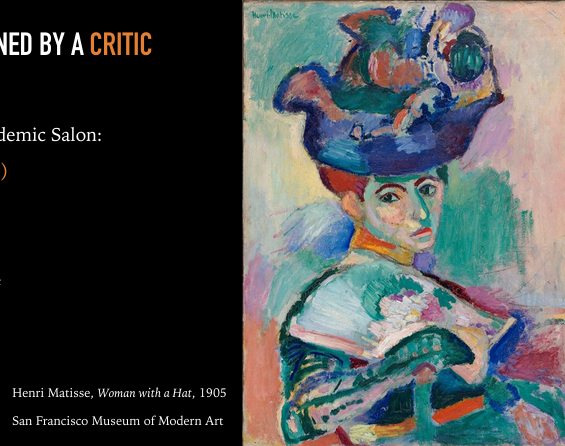
What was Expressionism, and where/when did it take place?
Between 1905 and 1920 (early 20th century)
Germany & Austria
Expression of emotions, psychological states
Expressive use of colour; Highly intense, non-naturalistic colours
Two groups: Die Brucke (The Bridge) & Der Blaue Reiter (The Blue Rider
Die Brucke: ‘bridge between art and society’
ex. painting of group member of Die Brucke, 1928
Der Blaue Reiter: from 1912 onwards, nature and animals, in particular, horses
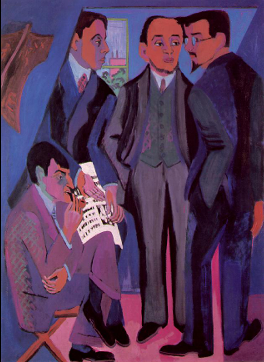
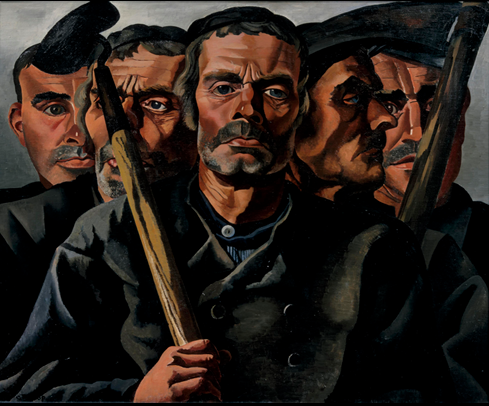
What was this painting, Boeren, 1930, By Charley Toorop, an example of? (seen at Centraal museum)
Expressionism ‘mixed’ with the subject matter of Realism: ‘an image of the people’
The painter exaggerates their facial features with harsh contrasts, speaking the “hardiness” of the working class. The French 19th century also had a motif of painting the working class, as this was also the time period of salons, and painting the working class was seen as an act of rebellion against the salons.
What was cubism and when/where did it take place?
Early 20th century
France
Geometric forms, fragmentation, multiple persectives
Flatness and assemblage
What was German Expressionism in a colonial context?
Dealt with objects and scenes with German colonies at the time, such as New Guinea
Appropriation of sculpture from New Guinea, then a German colony
Subject matter not modern, but done in a non-modern way
Color schemes that aren’t so naturalistic
What was early cubism?
Analytical
Structured dissection of the subject
fragmentary image
multiple perspectives
ex. Georges Braque, Glass on a Table, 1909-1910
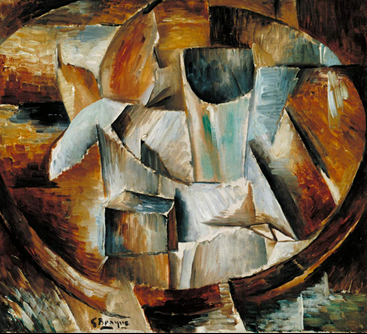
What was later cubism?
Synthetic
Integration of textures, patterns
Collage
Flatness, versus multiple perspectives
Not always easy to identify what is what
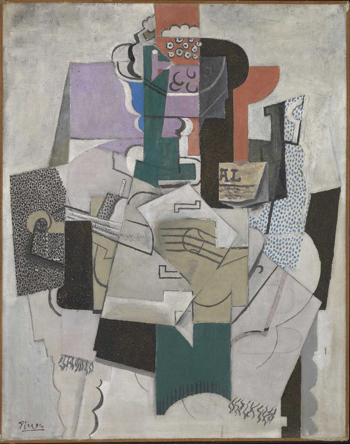
How was Primitivism seen in Cubism?
Integration of sculptures from the African continent, most prominently by Pablo Picasso, at the Musee du Trocadero in Paris
appropriating these objects to creat art
Another example of what is stylistically modern and what is more traditional
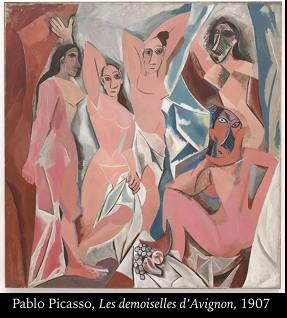
What was Futurism and when/where did it take place?
Since 1909 (early 20th century)
Italy
Modernity: speed, technology, violence
Bold colours and abstraction
Also embraced large crowds and movements
intersection of facism and futurism
Manifestoes, ex. Futurist Manifesto (1909) by Filippo Tommaso Marinetti
rejection of tradition (museums, libraries, etc.)
Embrace of technology, violence, and masculinity
Another example: Aeropittura (Aeropainting)
Romanticization/celebration of war; darker sides of modernity
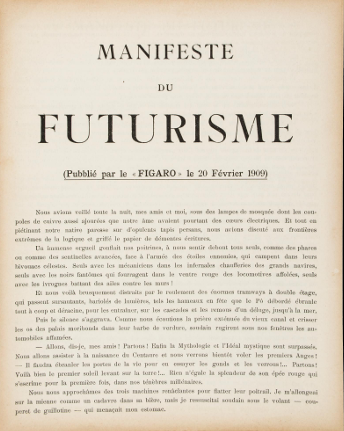
What is Dadaism and when/where did it happen?
Early twentieth century
Switzerland, international
Absurdity, anti-art, political and social critique
The Readymade (Objects which are ‘already made’); Marcel Duchamp (most famous artist)
Manifestoes
Ex. Dada Manifesto (1915) by Hugo Ball: Expression of absurdity through language & rejection of logic
Made into a non-logical, non-sensical language in 1917 —> Eurocentric implications*
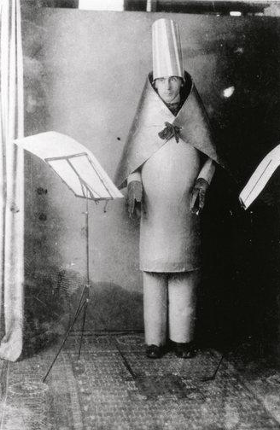
What was the impact of the readymade (dadaism)?
Showed the legitimizing power of the museum as an institution that grants objects the status of art
ex. Urinal by Marcel Duchamp (first rejected, then exhibited at the Society of Independent Artist’s Salon in New York in 1917)
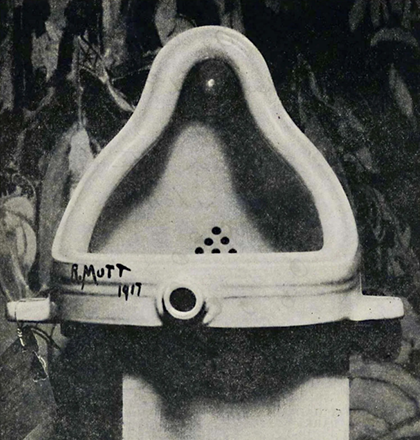
What was Hannah Hoch’s Political criticism?
Hoch did not agree with the position of the female in this painting
did not like the strategy of being unserious (satirical, irony, subversion)
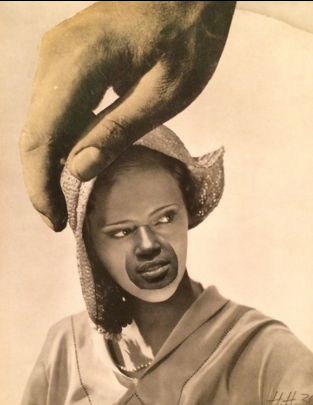
What was Surrealism and when/where did it take place?
Since 1924 (early 20th century)
France
Exploration of the unconscious, dreamlike imagery (like earlier Symbolism); not rational
Juxtapositions and subversion of traditional techniques
ex. J.H. Moseman, Self-portrait, 1935
Automatic drawing and writing: writing down anything that comes from their mind
Manifestoes ex. Surrealist Manifesto (1924) by Andre Breton
Rejection of rationality
Liberation from spiritual and social constraints
Inspiration from Sigmund Freud’s psychoanalysis

What was automatic drawing and writing and what movement was it from?
(Surrealism)
Writing down anything that comes to mind
What was Suprematism and when/where did it happen?
After 1915 (early 20th century)
Russia
Group of Russian ‘avant-garde’ artists
Rejection of representation
Geometric abstraction with spiritual ideals
Ex. Primacy of The Square: Black Square (1915)
Abstraction with religious and spiritual value: an attempt at an ‘absolute degree zero’
paintings that all could understand and feel emotional about compared to religious works
Suprematist Manifesto (1915) by Kazimir Malevich
Rejection of representation
Spiritual and Utopian vission
What is prehistory?
Refers to an age before the written record
lack of written records has no bearing on intellectual capabilities
How to deduce information from this period?
From scientific evidence: archaeological finds, geological records, contextual evidence, etc
carbon dating (organic things only)
What are the three stone ages?
Paleo-lithic (2.5 million - 200,000 BCE)
Meso-lithic (300,000 to 40,000 BCE)
Neo-lithic (40,000 to 4,000 BCE)
What was the Paleolithic (Old) stone age and what was it marked by?
longest period of human development, but also most static in both technical skill and creativity; that said, researchers believe that humans were developing both mentally and in their manual skill
marked by simple, crude stone artifacts ex. chopper, hammer stone. acheulean blade; items with practical value
2.5 or 2 million BCE until 200,000 BCE (~2 million years long)
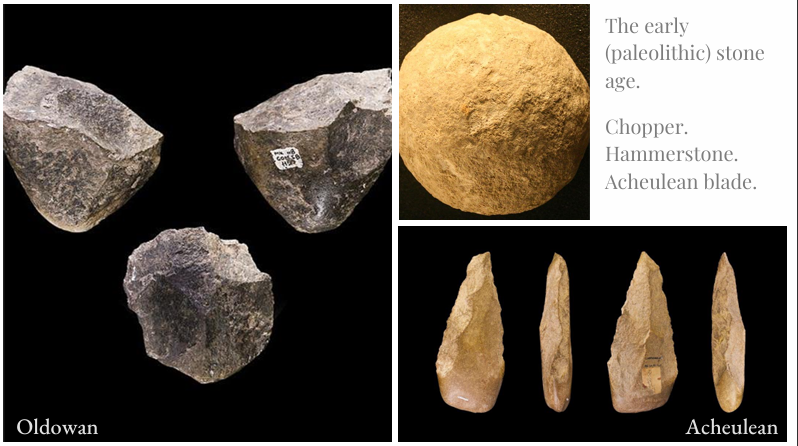
What was the Mesolithic (Middle) Stone Age and what was it marked by?
300,000 to 40,000 BCE
Had first clear signs of what we would consider fully artistic expression
ritualized behavior
production & use of ochre (pigments); starting to create markings using colored materials
shells/bones used as ornament/jewelry
Objects cast into (non-tool) functions
Abstract markings
Impermanent Visual Culture (Body art, ornamentation/jewelry, dance/rituals, story-telling, shamanism)
ex. Leaf-shaped spear heads from Germany (more chiseling observed)
What was the Neolithic (late) stone age and what was it marked by?
Shortest stone age but had the most artifacts
prehistoric cave paintings (similar motifs in Europe, Peru, etc)
Ex. Lascaux Grotto, Chauvet, Altamira
Parietal paintings = latin for cave wall paintings, lots of aurocs (large cattle) and other animals like horses, European rhinos, mammoths, etc
Incision & spray techniques
There were also tools like leaf blades, bone harpoons, and pendant with carved deer
Statues ex. Lion-man of Hohlenstein-Stadel (oldest confirmed statue; ritualistic function) and statues of Venus (represent fertility)

What were the three caves mentioned in class from the Neolithic stone age and what was important about each?
Lascaux Grotto, Chauvet, Altamira
Lascaux Grotto: Featured lots of aurocs (large cattle), horse and deer match the fossil record of Paleolithic period in that region, few human figures
Chauvet: aurocs, horses, European rhinos, mammoths, etc; ability to depict animals naturalistically
Altamira: polychrome ceiling has been called the “Sistine Chapel” of stone; 22,000 years of occupation; likely painted by singular painter
charcoal drawings, handprints (same type of paintings seen in China & Argentina
altar of bisons (dirt scultpures, hasn’t been fired, very delicate
What is the difference between artifacts and art?
Artifacts usually has a function, something from the past.
Art can be anything; more abstract, can be a dance, can be tangible or intangible
What is the timeline of ancient egypt?
3500 BCE: Early Human Civilization in the Nile Valley
3100 BCE: Pre & Early Dynastic Period; Pharaoh Narmer unites Egypt (Unification)
2600 BCE: Old Kingdom (The Age of Pyramids)
2050 BCE: Middle Kingdom (Middle Class Rises)
1550 BCE: New Kingdom (Hyksos dominate the North/Delta)
1501 BCE: Thutmose III
1361 BCE: King Tut
1303-1213 BCE: Ramesses III
31 BCE: ends with death of Cleopatra, Egypt becomes part of Roman Empire
What are the characteristics of Egyptian art?
Hierarchical scale/proportion: the size of the figure denotes its importance
Composite view: The head, arms, legs, and feet are depicted in profile, whereas the eyes and shoulders/torso are presented as seen from the front
Continuous Narrative: sequential scenes are shown within the same image
ex. Judgment scene from the Book of the Dead (version from 1275 BCE), British museum
figures are “flat” and face to the side of the work
Color palette (limited): red, green, blue, yellow, white, black; each has own symbolism ex. black means death & resurrection
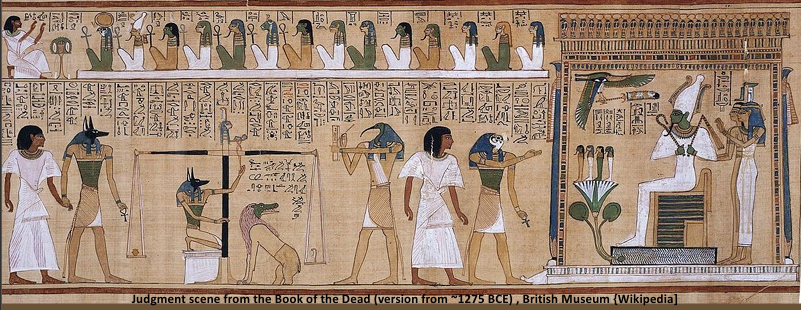
What was the significance of the Palette of Narmer? (Ancient Egypt)
Earliest example of art displaying the ancient Egyptian style
ca. 3200-3000 BC
makeup palette that visualizes and commemorates the unification of Upper and Lower Egypt, and the beginning of Dynastic Egypt
Idealization: The depiction of the pharaoh as an idealized, youthful, and athletic figure also reinforces the political message of the artwork —> the ruler appearing more eternal and divine than human
Has composite view (or twisted perspective), hierarchical scale, and registers (horizontal bands conventionally used to neatly order pictorial elements)
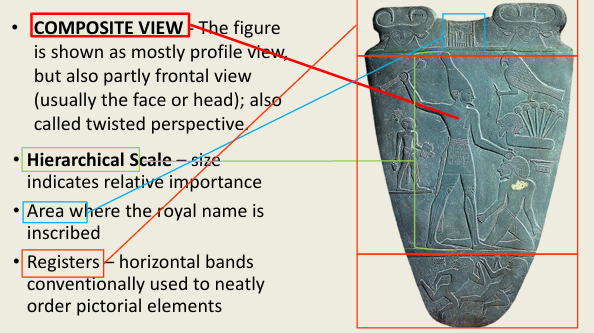
Give an example of an ancient Egyptian sculpture
The Seated Scribe from Saqqara
painted sculpture that exhibits a high level of Naturalism
depiction of realistic objects in a natural setting
Has a lifelike quality achieved through the painting of the plaster and the use of inlaid eyes
What is naturalism?
The depiction of realistic objects in a natural setting
What were mastabas?
low, flat tombs used by Egyptians built out of sun-dried bricks
—> led to the creation of step pyramids (one mastaba over another) —> led to mastabas built without steps and with a point, leading to true pyramid form
Egyptian religion placed great importance on what?
Placed great importance on the resurrection of the soul, or ka, and eternal life in the spirit world after death
What were the purpose of the pyramids? And give an example of a pyramid
No definitive answers, but primary theory is that they were burial structures
ex. Pyramid of Khufu, oldest and largest of the Giza pyramid complex
made from a sandstone and granite core with a brilliant white limestone casing
The last remaining of the Seven Wonders of the ancient world
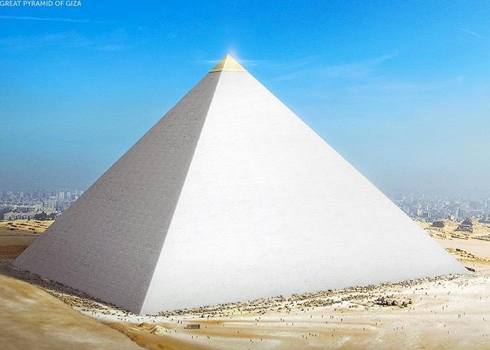
What were the characteristics of art from the Egyptian middle kingdom?
Don’t have a lot of info on them because they were destroyed by invaders and new kingdom
Increased sense of realism and more refined technique
What were the art characteristics of the Egyptian New Kingdom?
Ancient Egypt’s most prosperous age
Continued to embody the main principles of Egyptian art: frontality, hierarchy of scale, and composite composition
What were the characteristics of the Amarna period (ancient egypt)
1351-1344 BCE
sense of movement
activity in images
overlapping figures
busy and crowded scenes
change in how the human figure was portrayed
Hierarchy of scale not as prevalent
Style which was adopted during and just after the reign of Akhenaten, who abolished polytheism and initiated monotheistic form of worship called Atenism
Art becomes more realistic/naturalistic
Polytheism was eventually reinstated after Akhenaten’s rule
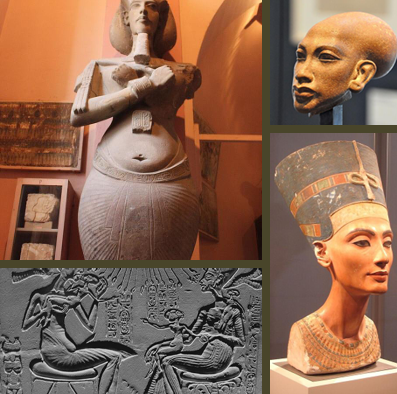
What is the importance of Madonna in Christian art?
Depiction of Virgin Mary, usually accompanied by a infant Christ, but she can also be shown alone
What are things to look for when visually analyzing a painting?
Balance, emphasis, movement, pattern, repetition, proportion, rhythm, variety, unity, scale
What is the timeline of the Ancient Mediterranean World?
Minoan: until 1600 BC
Mycenaen: 1600 - 1100 BC
Dark Ages: 1100 - 800 BC
Archaic: 800 - 480 BC (Greek vase paintings discussed in class developed during this period)
Classical: 480 - 323 BC
Hellenistic: 323 - 31 BC
What was the archaic period? (Ancient Greece)
800 - 480 BC
Witness the formation of a sculptural tradition: large-scale autonomous sculpture and monumental sculpture for buildings
Influenced by ancient Egypt but developed its own characteristics
Two major types of sculptures:
Kouros: free standing Ancient Greek youthful male nudes)
Kore: free standing Ancient Greek statues depicting youthful females
What were the similarities between Kouros (Ancient Greek male statues) and statues from ancient egypt?
eyes
way they are standing
hands held in a fist
front facing
very broad shoulders
not really realistic
Unlike egypt: back of sculpture is sculpted
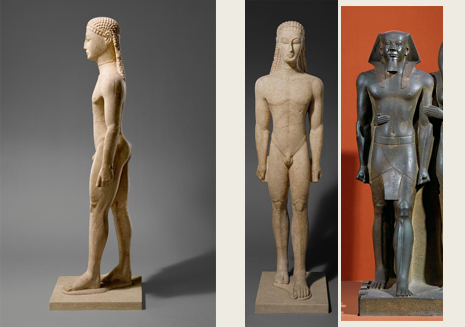
What happened during the Classical Period in Ancient Greece?
5th and 4th centuries
Introduction of democracy and the end of aristocratic culture
Changes of use of sculpture and increased technical skill, moving towards greater naturalism
Contrapposto: positioning of the body which had a contrast between rigid and relaxed elements —> allow viewer to feel the inner workings of the human body
Greek also had interest in athletics; artists studied athletes practicing to create figures in action ex. Poseidon/Zeus c. 460, Artemision Bronze
What is an example of a sculpture from the Ancient Greek classical period?
Kritos Boy, Acropolis, Athens, 480 BC (Early Classical style)
Harks back to Kouros
Moment of change from Archaic to Early Classical —> the flesh covers an organic structure of bone and muscle
First statue from classical antiquity known to use
Right leg (forward) bends at the knee so that the left leg appears to hold the body’s weight. Torso shifts so that the right hip and shoulder are lowered
—> contrast between rigid and relaxed elements allow the viewer to feel the inner workings of the human body
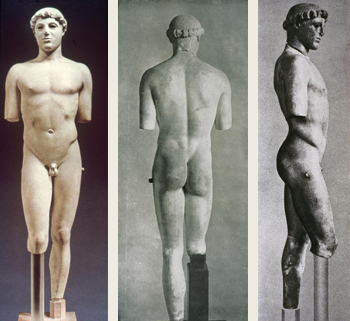
What happened during the Hellenistic period in Ancient Greece?
Start 4th century BC
The quest for the ideal
more dynamic pose, represented more freely
drapery, more complex
Accurately rendered but idealized human body
Different stances being used
ex. Diskobolos - Discus Thrower 460 - 450
very dynamic, more complicated pose, no more depicting figures that are just standing, built to be seen in the round
Depictions of Narratives
artwork showed scenes from the stores and events they are based off; focused on pain and suffering; tragic events; viewer has an idea of what is happening without any knowledge of the narrative itself; real historical events
ex. Laocoon Group in Rome (man fighting with his sons and snakes)
interplay between smooth and textured surfaces
heavy shadows + exquisite detail in the figure’s expressions and musculature
inspired renaissance and neoclassical art

What are the benefits of the Lost Wax Casting technique?
Allows casting of a sculpture that is empty inside
Able to create sculptures that were very thin, took less materials, and took much precision —> highly technical
Why was the Laocoon Group a key example of Hellenistic sculpture?
its emphasis on emotion and drama
Heavy shadows + exquisite detail in the figure’s expressions and musculature
Sculpture in the round, meant to be viewed from all sides
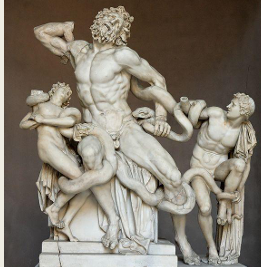
In ancient greece, what were the parallel developments in science/philosophy/art at the time?
science/philosophy: beginning of rational thought, shrugging off of myth as acceptable explanation, belief in a knowable world, beginnings of the developing the tools necessary to decipher that world; mathematics as a language to describe the world
art: saw a democratization of artistic expression; enthusiastic effort to learn to represent nature as it is (cf. Dutch 17th Golden Age); need to represent the ideal of the human body
What was the importance of pottery? (ancient greece)
Storage containers, cookware, and dishes
as necessary for the ancient greeks as they were for us
without much glass and with metal being expensive, clay was a very handy material
Could depict scenes from battle, daily life, ex. wedding, funeral purposes
What was black figure pottery (ancient greece)?
Beginning of 6th century BC
Consisted of painting figures with slip (watered down clay) that would turn black when the vase was fired
artists then incised details (such as hair, facial features, folds, and patterns in garments) onto the figures as well as paint (white paint —> women’s skin, red paint —> garments)
Mythology popular subject to depict on vases, patterns used to frame central scene
Ex. Attic black-figure amphora - Ajax and Achilles
amphora (string honey, oliva oil, water, wine, trophies)
spotlight effect

What was red figure pottery? (Ancient Greece)
appeared between 530-525 BC
Opposite to black figure; more complicated
artists paint around where he wants the figure to be, leaving the figure red and the background black
—> artist then paints the details onto the figure, instead of incising them

What is a peripteral temple?
Ancient greek temple which has an open space surrounded by a collonade
ex. temple of Apollo at Corinth c. 550 B.C. one of the earliest stone-built Doric temples.
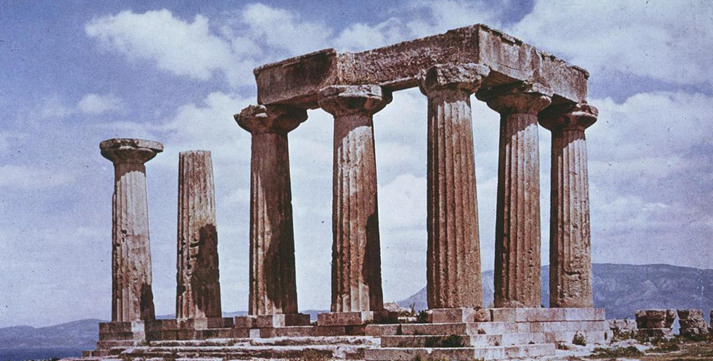
What are the three orders of ancient greek columns?
Doric order: very little ornamentation
Ionic order: capital has circular shape
Corinthian order: last to emerge; decorated with leaves
Know the names and shape of their capitals!
The Roman Empire spanned all around what sea?
The Mediterranean Sea
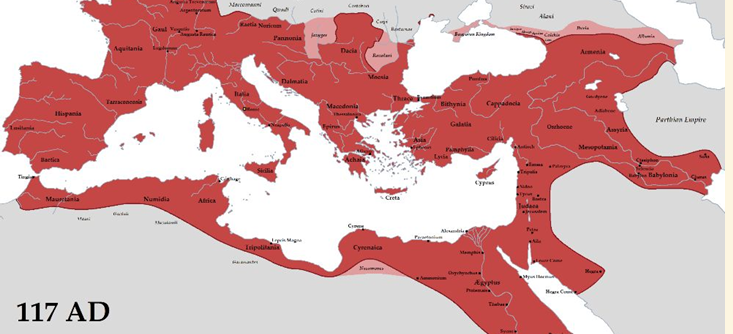
How did Greek Culture influence the Roman Empire
Greeks had colony in Sicily and southern Italy —> great impact on Roman art
Romans copied Greek paintings and sculptures, copied/borrowed Greek architecture & mythology, and borrowed/got influence from Greek Theatre
What are Frescos?
paintings on a wall
plaster a wall and you paint on it with pigments that are very watery
very durable medium that survives very well - thousands of years without natural calamities —> tell us about roman art
What were the three styles of roman paintings?
Oldest style: geometric colorful paintings on sculpture; try to mimic stone slabs/marble panels ex. Herod’s Lower Palace, Masada, Israel
2nd style: middle style, more architectural, ex. Pompeii 20-79 AD
3rd style: depicts scenes and more realism, ex. Wall Fresco from the Villa of Mysteries, Pompeii
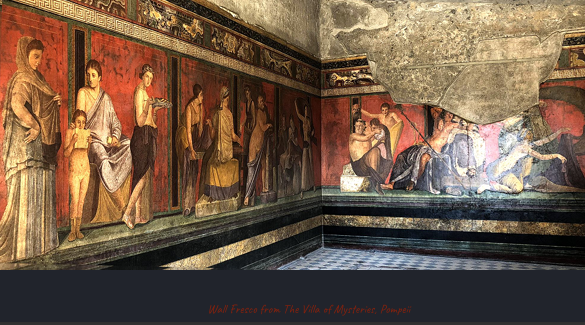
What are the main features we see in Roman Art?
interest in anatomy (ideal body shape like Greece, but also were more realistic; more wrinkles, unique nose)
Foreshortening (also seen in Greece): depiction of bodies in contorted positions or from a shorter angle, shows a maser of painting (painting difficult positions)
Sculptures also in distress to show mastery
Horns —> nod to represent strength, divinity, and aggressiveness. Horned gods often warriors.
Perspective
Color theory: very bold colors and juxtaposition
Drapery - how it folds over the human figures and puts them on display
Shading/lighting - mosaics
Very interested in naturalism at this time
Why are Late Hellenic (Greece) sculptures often indistinguishable from Roman sculptures?
because they are most likely hellenistc “import" copies or otherwise Greek products, because by 2nd century BCE, most “Roman” sculptors were Greek, often enslaved
Roman sculptprs were not respected, and unlike Greece, anonymous
Temples were often decorated with re-used Greek works
Vast numbers of Greek statues were “imported”
Why did Greek statues (made of Bronze) not survive as well as Roman statues (made of marble)?
Because bronze can melt while marble is more durable
What was the roman colosseum for?
For public functions, for spectacles, for entertainment for the masses, could stage naval battles (over 1000 gladiators a year died in these games)
What are some of the characteristics of the Pantheon in Rome?
constructed around a sphere
free standing dome
made of stone and concrete
covered in marble slabs
hole in the celling called the oculus
What was Byzantine Art an extension of?
Roman art
When did the Roman empire split?
395 AD by Emperor Constantine
When did Rome fall and why?
Rome fell in 476 AD, weakened by successive intrusions from Northern Germanic tribes
during this time, Eastern Roman Empire (Byzantine Empire) (330s-1453 AD) at arguably its greatest extent
What shift was observed in Byzantine art?
Shift towards a more abstract but also a universal forms, away from the naturalism and freedom of antiquity
born from a faith-based approach, and relied on stylization (non-realistic style
Pagan influences and style characterized by Christianity
Early depiction of jesus (reminiscent of roman gods such as Apollo, wearing roman military clothing)
ex. Christ Pantocrator, St. Catherines, Sinai Monastery, 6th century
depiction of jesus; two sides of face, one side is kinder and one is more the just; showed stylistic choices vs. realistic
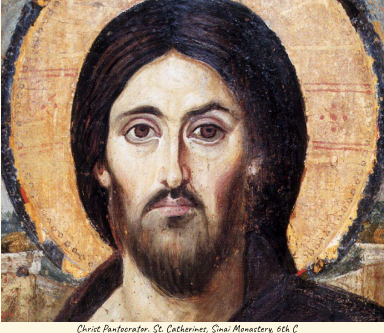
What is meant by “antiquity”?
The ancient past, or the time before the Middle Ages (500-1400 ce)
classical period, etc
What happened to the Roman Empire in the Early Middle Ages?
Incursion of Germanic tribes from the East, start invading and seizing parts of the Roman empire, weakening it significantly
After 500 AD, Western Rome is “gone”
Disease and poor health also made Rome more susceptible to invasion
As classical antiquity broke down, a new dynamic cultural space emerged. What other periods/genres influenced the 500-1000 AD period (Early Middle Ages) of the Roman Empire?
During this period, Europe becomes a melting pot of different cultures
Hellenistic Roman: Late Hellenistic Art had some minor lasting effects
Christian Roman: This genre heavily influenced this period
Byzantine Roman: Many Byzantine influences seeped into Western cultures
“Merovingian” (Frankish): The Franks (Germanic peoples) came early, creating a culture which fused Germanic, Gaulish, and Roman cultures
“Celtic” (Gaulish/Britannic): Parts of Britain / NW France (Brittany) and Ireland continued Celtic Culture
“Viking” (North Germanic): Northern Europeans (mainly Germans) continued Germanic culture wherever they invaded
What was the significance of the Gundestrup Cauldron?
Tipifys melting pot of styles at the time
Metal comes from Northern France (celtic silver)
Also materials from eastern and western half
Also different styles
range of figures, battle scnes, celtic armour, celtic motifs, celtic deities, battle scenes may be from celtic myths
stylistic influence from Roman art; God figure with the horns pouring grain; very roman cultural custom
What are characteristics of late Roman Jewelry? What caused changes?
Typicaly roman style of busts carved into gem stones
Starts to change with incoming germanic invasion, more patterning starting to occur
Very detailed patterning brought about by these German tribes
ex. Meringiuan Broaches
How was Germanic influence observed with the style of helmets?
Change in design/decoration of helmet
Roman: more simple
Germanic: more refined and intricate, figural patterns
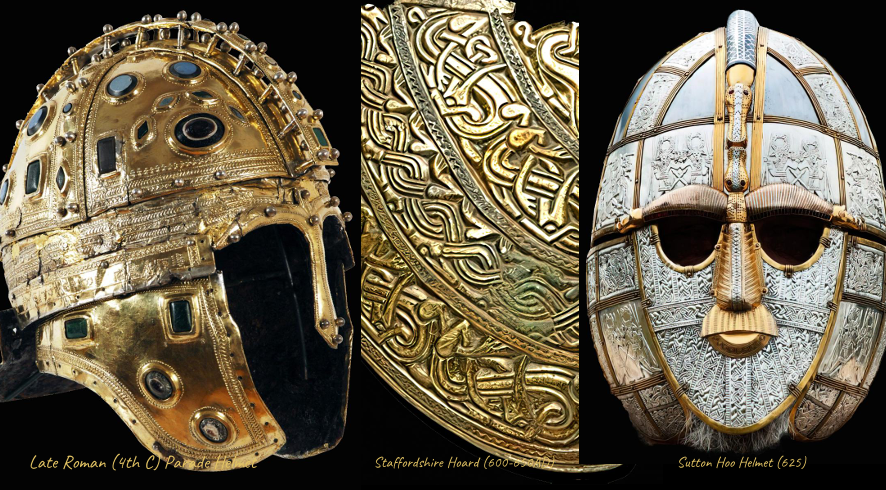
Why was Charlemagnes's reign so significant?
led to the production of Carolingian art, classic style
Crowned in 800 by pope, first acknowledgement of Germanic tribe emperor
We see how religion affects art; specifically, Christianity
had strong patronage of the arts —> return/renovation of Antiquity/ Roman classicism (classical figures, draped clothes)
copied early Christian models
Influence of contemporary Byzantine and Greco-Roman styles
What is classicism?
artwork that draws inspiration from ancient Roman or ancient Greek culture, architecture, literature, and art
What was characteristic of Northern Germanic Art?
ritualistic function
knotted beasts, common with celtic tribes, norse ship burial
starts to translate to christian art —> christian churches being decorated with Norse motifs
ex. Urnes, Stave Church, Door, Norway
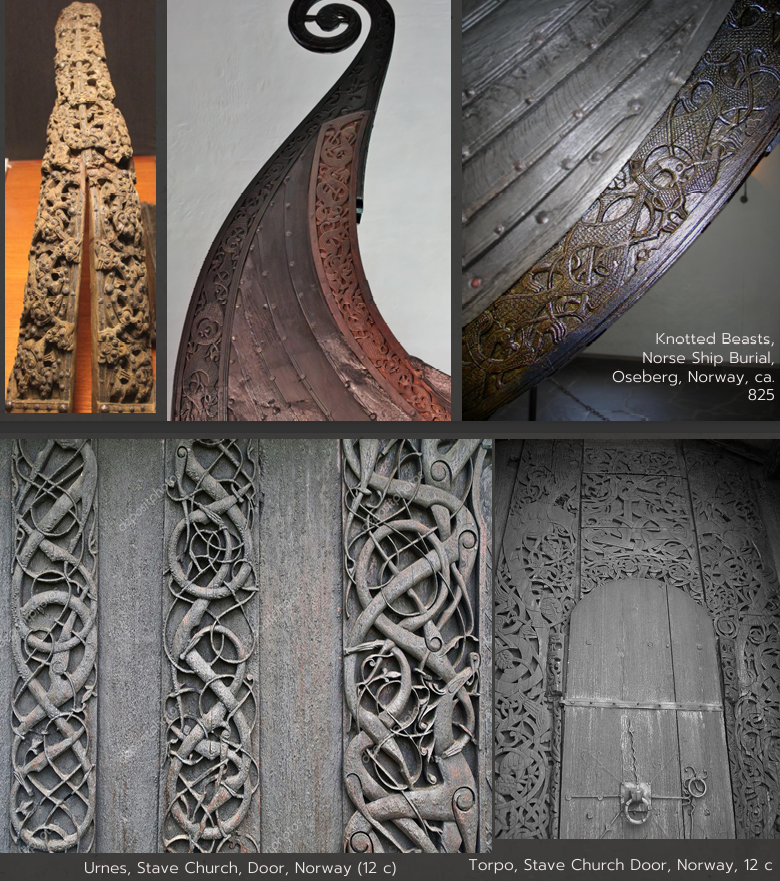
What was the book of kells?
A great combination of styles in one manuscript
one of the national treasures of ireland
produced in monastery in scotland or ireland
pages very richly decorated
What was the significance of the Palatine Chapel? What was it similar to? Why?
Built by Charlemagne to be his residence, seat of his empire
Begun 792, Aachen, Germany
Floor plan/patterning resembles late Roman structures
Charlemagne wanted to crown himself the new Christian King, so he copied older Christian chapels
Lots of similarities between Palatine chapel and San vitale Chapel
archways
figures lining the dome wearing similar togas
same figures
same gold background
